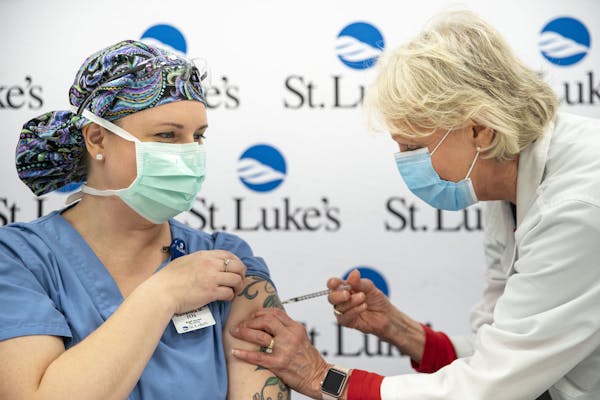Young athletes are no longer required to wear masks in outdoor competitions for COVID-19 prevention, state health officials said Thursday while urging them, and all middle and high school students, to seek testing to slow the pandemic.
While key indicators of pandemic activity such as hospitalizations have leveled off, the Minnesota Department of Health reported a record 1,088 infections with the coronavirus that causes COVID-19 among pre-K-12 students in the week ending April 17.
Only 10% of infections in children and teens produce severe illness, but the rest can fuel viral spread, state Health Commissioner Jan Malcolm said. "Even a mildly ill or completely asymptomatic child can transmit the virus to more vulnerable people in their family or broader community."
Testing is advised every two weeks for middle and high school students, and every week for athletes, referees and coaches. To increase access, the state on Thursday offered to provide school districts and sports clubs with free mail-in kits to test students and athletes.
"We all want to make sure that our students can have the prom and graduation ceremonies and everything else that comes with an end of a great school year," said Heather Mueller, state Education Commissioner and a mother of two high school students. "Testing is one of the ways to be able to get that."
Relief from outdoor mask-wearing was requested last week by an advisory panel of the Minnesota State High School League. Masks under the new policy are optional for athletes in outdoor games or matches but still required for most indoor team competitions and for anyone on the sidelines or benches.
The move drew measured support from Let Them Play MN, an advocacy group that opposed Minnesota's pause on youth athletics in November and the mask-wearing and restrictions that followed when play resumed in January.
The group in a lawsuit alleged that Minnesota lacked scientific proof that sports presented elevated risk of viral transmission or posed a risk of spreading the virus to vulnerable elderly or long-term care residents. It also documented instances of injuries when athletes lacked visibility or couldn't breathe during competition.
"While we are pleased one baseless restriction has ended, Let Them Play will continue to fight until Governor [Tim] Walz and MDH have eliminated all unfair restrictions on sports," said Dawn Gillman, the organization's founder and the mother of two multisport teenagers in Dassel, Minn.
Minnesota has reported 607 sports-related COVID-19 outbreaks — defined as at least two infections among members of the same team who have no other transmission sources in common.
Outbreaks sometimes involved viral transmission in social activities after games and practices, but Malcolm said there has been ample epidemiological evidence of the role of sports in community COVID-19 transmission. Genomic sequencing of an outbreak centered on sports in Carver County this year showed transmission across teams, schools, day cares, fitness clubs and workplaces.
Increased testing will find more infections before the virus spreads across such groups, Malcolm said. "We want to find all the cases we can find so we can interrupt those chains of transmission."
Whether schools and students will seek more testing is unclear. The Health Department last fall received multiple reports of high school teams engaging in no-testing pacts to avoid potential quarantines if a player was infected.
Roughly 139,000 COVID-19 tests have been conducted as part of a state pre-K-12 program that offers testing to staff every two weeks. Districts learned on Thursday of the new extension to offer testing for students as well but hadn't made decisions about it.
"We need to examine what it would take from an operations standpoint and learn more about [state] support for schools in making the testing program work as effectively as possible," said Barbara Olson, a spokeswoman for Osseo Area Schools.
The one-week record of pre-K-12 student infections in the week of April 17 came without similar growth among educators. The 178 pre-K-12 staff infections that week compared with a high of 758 in mid-November.
At least 69% of pre-K-12 educators have received COVID-19 vaccine, which health officials believe has controlled the spread in that population. However, the state on Thursday reported a sixth death in the pandemic of a pre-K-12 educator.
Overall, more than 53% of eligible Minnesotans 16 and older have received at least a first dose of vaccine, including more than 85% of senior citizens who have suffered the majority of COVID-19 deaths.
Minnesota on Thursday reported another 10 COVID-19 deaths and 1,973 infections — raising its pandemic totals to 7,054 deaths and 562,420 infections. Hospitalizations for COVID-19 in Minnesota increased slightly to 683 on Wednesday and included 196 people in intensive care.
Dr. Brooke Moore, a pediatric pulmonologist with Children's Minnesota, said her system's hospitals have admitted 395 pediatric COVID-19 patients since the start of the pandemic, including 88 who needed intensive care. The hospitals last week had 11 new COVID-19 admissions and placed five children in pediatric intensive care.
Health officials urged teenagers 16 and older to seek vaccine in addition to testing, especially with some providers reporting more availability.
St. Luke's in Duluth announced it had openings for vaccination this week and recommended that students seek out shots.
People no longer need to be a "computer ninja" to snatch up online appointments or worry about other people more in need of getting shots first, said Kris Ehresmann, state infectious disease director. "Thank you for allowing others to go first, but it's OK now to take your place in line."
Staff writer Erin Golden contributed to this report.
Jeremy Olson • 612-673-7744

Edina could see first zoning update in 50 years

Will this be the year legislators abolish "shotgun only'' for deer across southern Minnesota?

